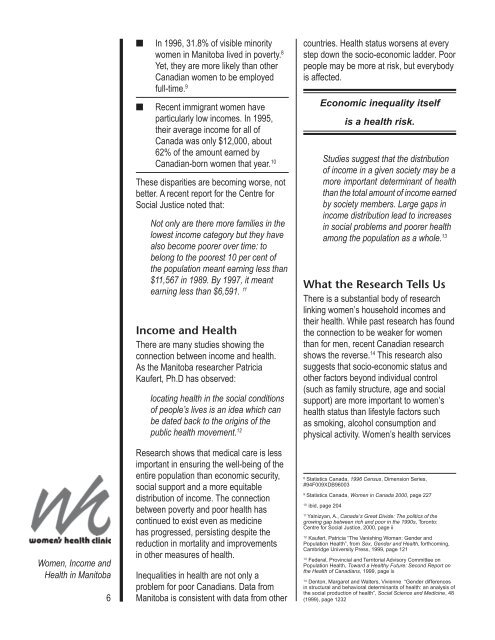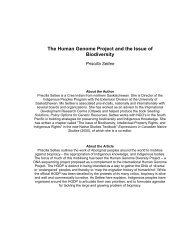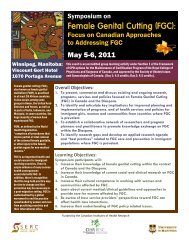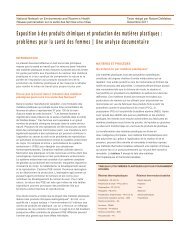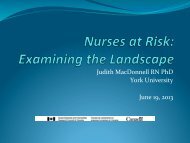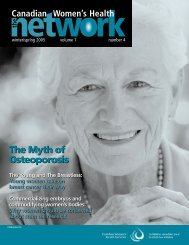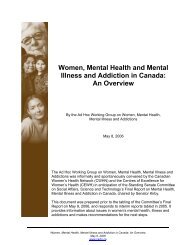here. - Canadian Women's Health Network
here. - Canadian Women's Health Network
here. - Canadian Women's Health Network
- No tags were found...
You also want an ePaper? Increase the reach of your titles
YUMPU automatically turns print PDFs into web optimized ePapers that Google loves.
Women, Income and<strong>Health</strong> in Manitoba6■■In 1996, 31.8% of visible minoritywomen in Manitoba lived in poverty. 8Yet, they are more likely than other<strong>Canadian</strong> women to be employedfull-time. 9Recent immigrant women haveparticularly low incomes. In 1995,their average income for all ofCanada was only $12,000, about62% of the amount earned by<strong>Canadian</strong>-born women that year. 10These disparities are becoming worse, notbetter. A recent report for the Centre forSocial Justice noted that:Not only are t<strong>here</strong> more families in thelowest income category but they havealso become poorer over time: tobelong to the poorest 10 per cent ofthe population meant earning less than$11,567 in 1989. By 1997, it meantearning less than $6,591. 11Income and <strong>Health</strong>T<strong>here</strong> are many studies showing theconnection between income and health.As the Manitoba researcher PatriciaKaufert, Ph.D has observed:locating health in the social conditionsof people’s lives is an idea which canbe dated back to the origins of thepublic health movement. 12Research shows that medical care is lessimportant in ensuring the well-being of theentire population than economic security,social support and a more equitabledistribution of income. The connectionbetween poverty and poor health hascontinued to exist even as medicinehas progressed, persisting despite t<strong>here</strong>duction in mortality and improvementsin other measures of health.Inequalities in health are not only aproblem for poor <strong>Canadian</strong>s. Data fromManitoba is consistent with data from othercountries. <strong>Health</strong> status worsens at everystep down the socio-economic ladder. Poorpeople may be more at risk, but everybodyis affected.Economic inequality itselfis a health risk.Studies suggest that the distributionof income in a given society may be amore important determinant of healththan the total amount of income earnedby society members. Large gaps inincome distribution lead to increasesin social problems and poorer healthamong the population as a whole. 13What the Research Tells UsT<strong>here</strong> is a substantial body of researchlinking women’s household incomes andtheir health. While past research has foundthe connection to be weaker for womenthan for men, recent <strong>Canadian</strong> researchshows the reverse. 14 This research alsosuggests that socio-economic status andother factors beyond individual control(such as family structure, age and socialsupport) are more important to women’shealth status than lifestyle factors suchas smoking, alcohol consumption andphysical activity. Women’s health services8Statistics Canada, 1996 Census, Dimension Series,#94F009XDB960039Statistics Canada, Women in Canada 2000, page 22710ibid, page 20411Yalnizyan, A., Canada’s Great Divide: The politics of thegrowing gap between rich and poor in the 1990s, Toronto:Centre for Social Justice, 2000, page ii12Kaufert, Patricia “The Vanishing Woman: Gender andPopulation <strong>Health</strong>”, from Sex, Gender and <strong>Health</strong>, forthcoming,Cambridge University Press, 1999, page 12113Federal, Provincial and Territorial Advisory Committee onPopulation <strong>Health</strong>, Toward a <strong>Health</strong>y Future: Second Report onthe <strong>Health</strong> of <strong>Canadian</strong>s, 1999, page ix14Denton, Margaret and Walters, Vivienne “Gender differencesin structural and behavioral determinants of health: an analysis ofthe social production of health”, Social Science and Medicine, 48(1999), page 1232


